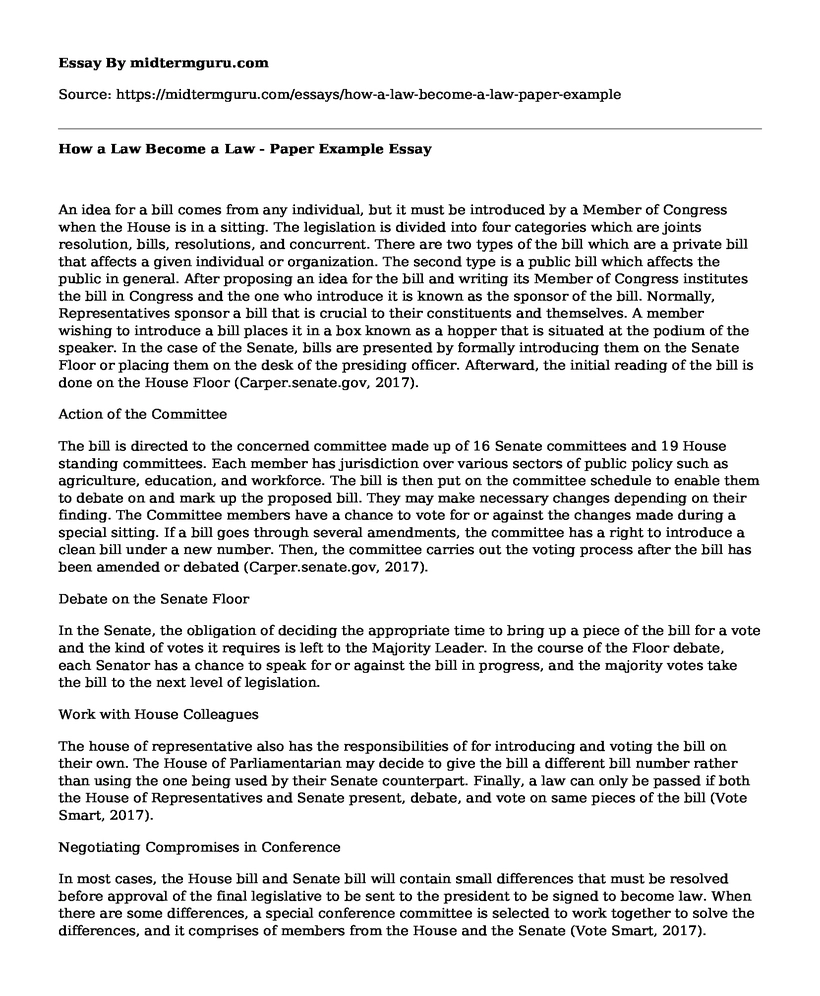An idea for a bill comes from any individual, but it must be introduced by a Member of Congress when the House is in a sitting. The legislation is divided into four categories which are joints resolution, bills, resolutions, and concurrent. There are two types of the bill which are a private bill that affects a given individual or organization. The second type is a public bill which affects the public in general. After proposing an idea for the bill and writing its Member of Congress institutes the bill in Congress and the one who introduce it is known as the sponsor of the bill. Normally, Representatives sponsor a bill that is crucial to their constituents and themselves. A member wishing to introduce a bill places it in a box known as a hopper that is situated at the podium of the speaker. In the case of the Senate, bills are presented by formally introducing them on the Senate Floor or placing them on the desk of the presiding officer. Afterward, the initial reading of the bill is done on the House Floor (Carper.senate.gov, 2017).
Action of the Committee
The bill is directed to the concerned committee made up of 16 Senate committees and 19 House standing committees. Each member has jurisdiction over various sectors of public policy such as agriculture, education, and workforce. The bill is then put on the committee schedule to enable them to debate on and mark up the proposed bill. They may make necessary changes depending on their finding. The Committee members have a chance to vote for or against the changes made during a special sitting. If a bill goes through several amendments, the committee has a right to introduce a clean bill under a new number. Then, the committee carries out the voting process after the bill has been amended or debated (Carper.senate.gov, 2017).
Debate on the Senate Floor
In the Senate, the obligation of deciding the appropriate time to bring up a piece of the bill for a vote and the kind of votes it requires is left to the Majority Leader. In the course of the Floor debate, each Senator has a chance to speak for or against the bill in progress, and the majority votes take the bill to the next level of legislation.
Work with House Colleagues
The house of representative also has the responsibilities of for introducing and voting the bill on their own. The House of Parliamentarian may decide to give the bill a different bill number rather than using the one being used by their Senate counterpart. Finally, a law can only be passed if both the House of Representatives and Senate present, debate, and vote on same pieces of the bill (Vote Smart, 2017).
Negotiating Compromises in Conference
In most cases, the House bill and Senate bill will contain small differences that must be resolved before approval of the final legislative to be sent to the president to be signed to become law. When there are some differences, a special conference committee is selected to work together to solve the differences, and it comprises of members from the House and the Senate (Vote Smart, 2017).
Sending President for a signature
After the committee has solved the differences in the bill, it is taken back both House and the Senate to be voted once more, and the final draft is approved. Then, the president is the one who makes the final decision on whether to sign the bill into law or not. If the president approves to sign the bill, it automatically becomes law but if he refuses the bill becomes null.
References
Carper.senate.gov. (2017). How a Bill Becomes a Law - Legislation - Tom Carper, U.S. Senator for Delaware. Retrieved from http://www.carper.senate.gov/public/index.cfm/how-a-bill-becomes-a-law
Vote Smart. (2017). Government 101: How a Bill Becomes Law. Retrieved from
https://votesmart.org/education/how-a-bill-becomes-law#.WItr_dJ95dj
Cite this page
How a Law Become a Law - Paper Example. (2021, May 31). Retrieved from https://midtermguru.com/essays/how-a-law-become-a-law-paper-example
If you are the original author of this essay and no longer wish to have it published on the midtermguru.com website, please click below to request its removal:
- Roy Williams Category B: Themes of Power, Race, and Prison Structure
- A Letter of Inquiry to the Ex-Husband With a Request to See the Children
- Essay Sample on Criminal Justice System
- Women's Rights, Animal Rights and Euthanasia Paper Example
- Paper Example on Killing: An Ethical Perspective
- John F. Kennedy Assassination: Shockwave Across America - Essay Sample
- United Nations and Humanitarian Assistance - Essay Sample







